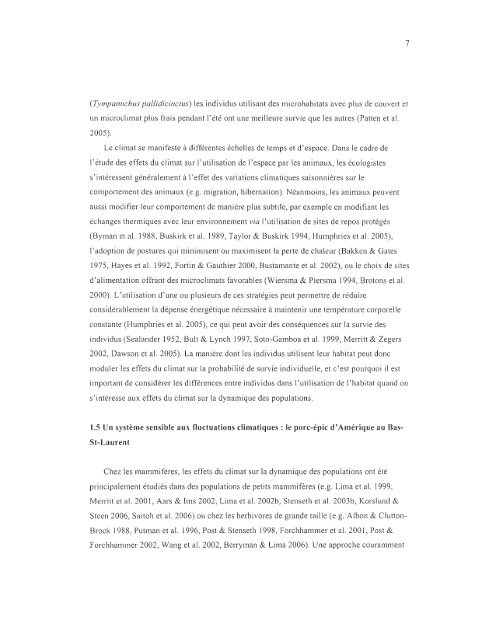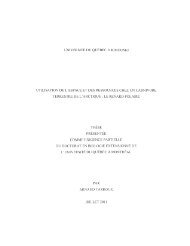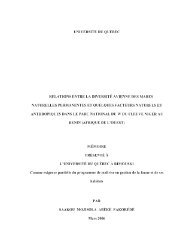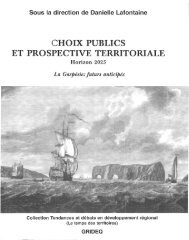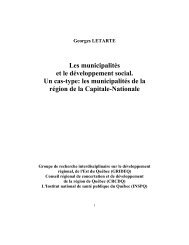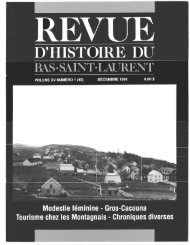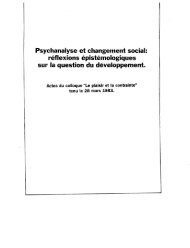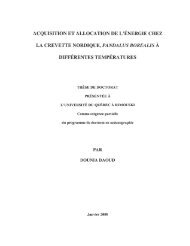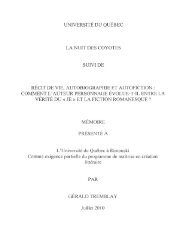influence du climat et de la prédation sur l'utilisation de l'habitat et la ...
influence du climat et de la prédation sur l'utilisation de l'habitat et la ...
influence du climat et de la prédation sur l'utilisation de l'habitat et la ...
Create successful ePaper yourself
Turn your PDF publications into a flip-book with our unique Google optimized e-Paper software.
7<br />
(Tympanuchus pallidicinctus) les indivi<strong>du</strong>s utilisant <strong>de</strong>s microhabitats avec plus <strong>de</strong> couveli <strong>et</strong><br />
un micro<strong>climat</strong> plus frais pendant l'été ont une meilleure <strong>sur</strong>vie que les autres (Patten <strong>et</strong> al.<br />
2005).<br />
Le <strong>climat</strong> se manifeste à différentes échelles <strong>de</strong> temps <strong>et</strong> d'espace. Dans le cadre <strong>de</strong><br />
l' étu<strong>de</strong> <strong>de</strong>s eff<strong>et</strong>s <strong>du</strong> <strong>climat</strong> <strong>sur</strong> l' utilisation <strong>de</strong> l'espace par les animaux, les écologistes<br />
s' intéressent généralement à l'eff<strong>et</strong> <strong>de</strong>s variations <strong>climat</strong>iques saisonnières <strong>sur</strong> le<br />
comportement <strong>de</strong>s animaux (e.g. migrati on, hibernati on). Néanmoins, les animaux peuvent<br />
aussi modifier leur comportement <strong>de</strong> mani ère plus subtile, par exemple en modifiant les<br />
échanges thermiques avec leur environnement via l' utilisation <strong>de</strong> sites <strong>de</strong> repos protégés<br />
(Byman <strong>et</strong> al. 1988, Buskirk <strong>et</strong> al. 1989, Taylor & Buskirk 1994, Humphries <strong>et</strong> al. 2005),<br />
l'adoption <strong>de</strong> postures qui minimisent ou maximisent <strong>la</strong> perte <strong>de</strong> chaleur (Bak.ken & Gates<br />
1975, Hayes <strong>et</strong> al. 1992, Fortin & Gauthier 2000, Bustamante <strong>et</strong> al. 2002), ou le choix <strong>de</strong> sites<br />
d'alimentati on offrant <strong>de</strong>s micro<strong>climat</strong>s favorables (Wiersma & Piersma 1994, Brotons <strong>et</strong> al.<br />
2000). L' utilisation d' une ou plusieurs <strong>de</strong> ces stratégies peut perm<strong>et</strong>tre <strong>de</strong> ré<strong>du</strong>ire<br />
considérablement <strong>la</strong> dépense énergétique nécessaire à maintenir une température corporelle<br />
constante (Humphries <strong>et</strong> al. 2005), ce qui peut avoir <strong>de</strong>s conséquences <strong>sur</strong> <strong>la</strong> <strong>sur</strong>vie <strong>de</strong>s<br />
indi vi<strong>du</strong>s (Sea1an<strong>de</strong>r 1952, Bult & Lynch 1997, Soto-Gamboa <strong>et</strong> al. 1999, Merritt & Zegers<br />
2002, Dawson <strong>et</strong> al. 2005). La mani ère dont les indivi<strong>du</strong>s utilisent leur habitat peut donc<br />
mo<strong>du</strong>ler les eff<strong>et</strong>s <strong>du</strong> <strong>climat</strong> <strong>sur</strong> <strong>la</strong> probabilité <strong>de</strong> <strong>sur</strong>vie indivi<strong>du</strong>elle, <strong>et</strong> c'est pourquoi il est<br />
important <strong>de</strong> considérer les différences entre indivi<strong>du</strong>s dans l' util isati on <strong>de</strong> 1 ' habitat quand on<br />
s' intéresse aux eff<strong>et</strong>s <strong>du</strong> <strong>climat</strong> <strong>sur</strong> <strong>la</strong> dynamique <strong>de</strong>s popu<strong>la</strong>ti ons.<br />
1.5 Un système sensible aux fluctuations <strong>climat</strong>iques: le porc-épie d'Amérique au Bas<br />
St-Laurent<br />
Chez les mammifères, les eff<strong>et</strong>s <strong>du</strong> <strong>climat</strong> <strong>sur</strong> <strong>la</strong> dynamique <strong>de</strong>s popu<strong>la</strong>tions ont été<br />
principalement étudiés dans <strong>de</strong>s popu<strong>la</strong>ti ons <strong>de</strong> p<strong>et</strong>its mammifères (e.g. Lima <strong>et</strong> al. 1999,<br />
Merritt <strong>et</strong> a l. 2001 , Aars & Ims 2002, Lima <strong>et</strong> al. 2002b, Stens<strong>et</strong>h <strong>et</strong> a l. 2003b, Korslund &<br />
Steen 2006, Saitoh <strong>et</strong> al. 2006) ou chez les herbivores <strong>de</strong> gran<strong>de</strong> taille (e.g. Albon & Clutton-<br />
Brock 1988, Putman <strong>et</strong> al. 1996, Post & Stens<strong>et</strong>h 1998, Forchhammer <strong>et</strong> al. 200 1, Post &<br />
Forchhammer 2002, Wang <strong>et</strong> al. 2002, Berryman & Lima 2006). Une approche couramment


